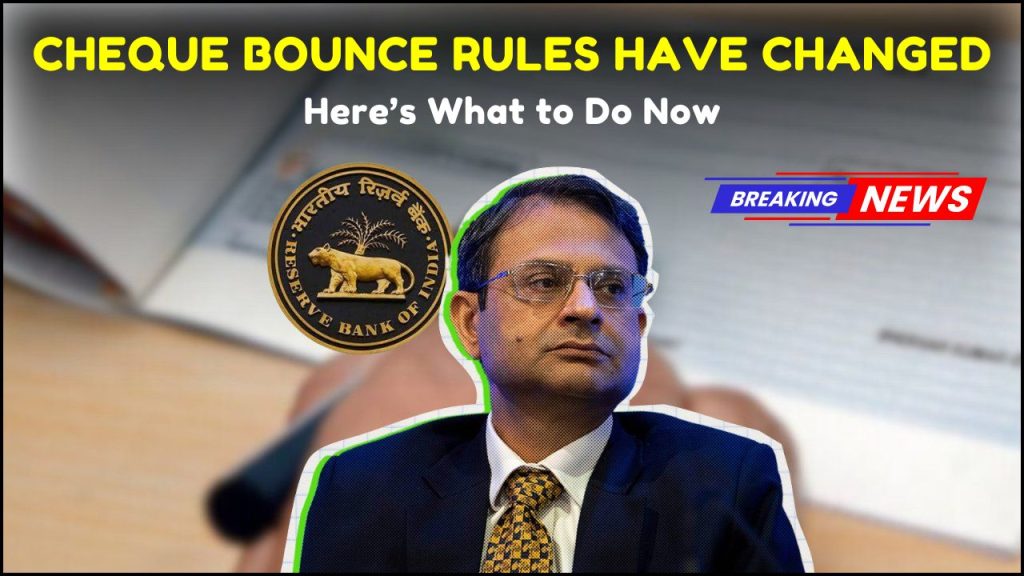
In 2025, India made big changes to how cheque bounce cases are handled. These new rules affect everyone who uses cheques – both regular people and businesses. Understanding these changes will help you avoid legal troubles and save time and money.
What Are Cheque Bounce Rules?
When you write a cheque, you promise that you have enough money in your bank account to cover it. If your bank rejects (or “bounces”) the cheque because you don’t have enough money, you could face legal problems. The new 2025 rules make these problems more serious.
Main Changes in the 2025 Rules
The government created these new rules to:
- Make cases move faster through courts
- Reduce the number of cheque bounce cases
- Make people more careful when writing cheques
Here are the most important changes:
1. Bigger Penalties
The fines for bounced cheques have increased significantly. This means you’ll pay more if your cheque bounces in 2025 compared to previous years.
2. Faster Court Cases
Courts will now process cheque bounce cases more quickly. This means less waiting time, but also less time for you to prepare if someone takes you to court.
3. Digital Evidence Accepted
Courts now accept digital records as evidence. This includes screenshots of bank statements, digital payment records, and online communication about payments.
4. Required Notices
If someone’s cheque to you bounces, you must send them a legal notice within a specific period if you want to take legal action.
5. Special Courts
Some areas may set up special courts just for cheque bounce cases. This helps cases move faster through the legal system.
6. Stricter Accountability
People who write cheques that bounce will face more scrutiny and stronger consequences than before.
7. Options to Settle Outside Court
The new rules encourage people to settle cheque disputes without going to court, saving time and reducing court backlogs.
How to Avoid Cheque Bounce Problems
Follow these simple steps to stay out of trouble:
Always Keep Enough Money in Your Account
Before writing a cheque, make sure you have enough money in your bank account. This is the simplest way to avoid problems.
Keep Track of Your Money
- Check your account balance regularly
- Set up low balance alerts from your bank
- Keep a record of all cheques you write
- Make sure you don’t spend money you’ve already promised in a cheque
Switch to Digital Payments When Possible
Digital payments are often safer and more reliable than cheques:
- Use online banking for direct transfers
- Try UPI for quick payments
- Use mobile payment apps for small transactions
- Set up automatic payments for regular bills
Double-Check All Cheque Details
Small mistakes can cause big problems:
- Write the correct date
- Spell the receiver’s name correctly
- Write the amount clearly in both numbers and words
- Sign the cheque properly
- Use good-quality ink that won’t fade
Communicate About Payment Issues
If you know your cheque might bounce:
- Contact the person you gave the cheque to immediately
- Explain the situation honestly
- Offer alternative payment methods
- Make arrangements to pay as soon as possible
Legal Consequences of a Bounced Cheque
If your cheque bounces, you could face:
Criminal Charges
Under Section 138 of the Negotiable Instruments Act, you could face criminal charges for a bounced cheque.
Civil Lawsuits
The person you gave the cheque to could sue you to recover the money.
Damage to Your Credit Score
Bounced cheques can hurt your credit score, making it harder to get loans in the future.
Bank Penalties
Your bank might charge you fees or limit your account if you have multiple bounced cheques.
Legal Costs
Fighting a cheque bounce case in court costs money – sometimes more than the cheque amount itself.
Reputation Damage
People and businesses might become unwilling to accept your cheques in the future.
What to Do If You Receive a Bounced Cheque
If someone gives you a cheque that bounces:
- Contact them immediately to discuss the issue
- Keep records of all communications
- Send a formal notice within the required period
- Consider seeking legal advice if the amount is large
- Try to settle the matter outside the court if possible
Common Questions About the New Rules
1. What exactly are the new penalties?
The penalties have increased significantly to discourage people from writing bad cheques. Specific fine amounts depend on the cheque value.
2. How much faster will cases be resolved?
With the new streamlined procedures, cases that previously took years might now be resolved in months.
3. Do I need to keep paper records?
While paper records are still useful, digital records are now accepted as evidence. Keep both when possible.
4. Should I stop using cheques completely?
Not necessarily, but consider using digital payments for most transactions and save cheques for situations where they’re specifically required.
5. What’s the time limit for sending a notice about a bounced cheque?
You must send a legal notice within 30 days of receiving the cheque bounce information from the bank.
Expert Advice
Legal experts and banking officials generally agree that these changes are positive:
“These new rules will reduce court backlogs and make the system more efficient,” says one legal expert.
A banking official notes, “Digital evidence acceptance will make the process much more straightforward for everyone involved.”
Financial advisors recommend, “Use this opportunity to review your payment habits and consider switching to digital methods where appropriate.”
Final Thoughts
The 2025 cheque bounce rule changes are designed to create a more responsible financial system. By understanding these rules and following good practices, you can avoid legal problems and manage your finances more effectively.
Remember: The best way to avoid cheque bounce issues is to always ensure you have enough money in your account before writing a cheque, and to consider digital payment alternatives whenever possible.
Stay informed, be proactive, and maintain good financial habits to navigate these new rules successfully.

Katherine Johnson is a passionate writer with a keen interest in storytelling, content creation, and creative expression. She enjoys exploring diverse topics and crafting engaging narratives that captivate readers.



